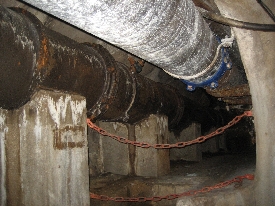
Some of the best sights in Paris are the ones underground – the catacombs of Paris, the Paris Crypt, and the Paris Sewers. The Paris Sewers provide people with something really different, and a little bit stinky, to see while in Paris.
Paris is a big city with a very long history. From its early days as a Roman outpost through modern times, the city has had to deal with waste. How would they handle waste from millions of people? In ancient times, it wasn’t a problem. The population wasn’t large enough yet to create any real pollution, so everything went into the River Seine. Sure, the streets were dirty and smelled but it wasn’t like the East River in NYC.
However, as the city grew, more waste went into the Seine and, by the late middle ages, the river was simply too polluted. Something needed to be done. Beginning in 1370, the city started building sewers and drains. Back then, people just threw their waste onto the street where it just sort of stayed. This was a common practice all over Europe up until the 19th century. In fact, part of the reason women began carrying those little parasols in the late 18th/19th century was to protect themselves from falling… debris.


In Paris, the system got bigger and bigger, but it still wasn’t effective. Waste still went into the Seine, and the stink just got worse. In the 19th century, the city employed Eugene Belgrand, who reshaped everything. He increased the sewer system, increased the size of the drains and roads, started a treatment plant, and began to build aqueducts so the city could pump in drinking water from the surrounding area. Much of the sewer system still bears his legacy. The city now has over 2,100 km of pipelines that, if stretched out, would go from Paris to Istanbul. It’s the biggest in the world and deals with over 1.2 million cubic meters of waste water each day.
For those interested in seeing this, the Paris Sewer tour lets you explore part of the sewers and learn how the city copes with all its waste. The exhibit is quite good, with most of the signs in French, German, and English. Moreover, you actually get to walk through some of the active sewers. You can hear the waste flowing to its final destination below you. It makes for quite the stinky time, though I must say you do get used to the smell after a while.

The tour is laid out in a quick and easy walk that can be done in 30 minutes or less. In the beginning, there are some pictures and information on the history of the sewers as well as some of the old machines they used to clean them. There seems to be a great display with visual images and everything. How good it is, I don’t know- this part was in French. The other major exhibit on the history of the sewers is in multiple languages. The Paris Sewers are a different way to see Paris and give you an interesting take on how this modern city deals with an age old problem.
Everyone comes to Paris to see the Louvre, the Eiffel Tower, and Notre Dame. Come see something different (and stinky), and learn more about the workings of this city. It was one of the most unique things I’ve done. Plus, there are no lines.
You can find the Paris Sewer Tour near the Alma Marceau metro stop. It’s right across the bridge on your left. It’s open every day except Thursday and Friday from 11 A.M. to 5 P.M. and costs 4.50 Euros to get in.
Make sure to bring some hand sanitizer for when you are done!